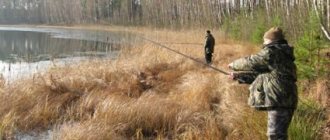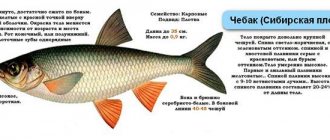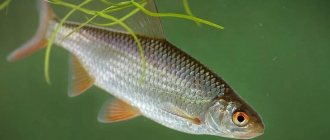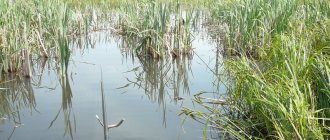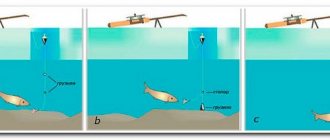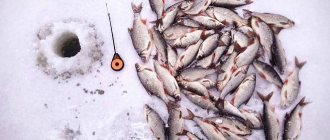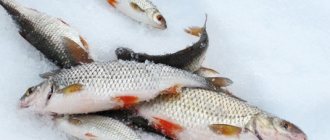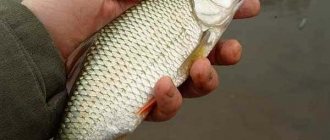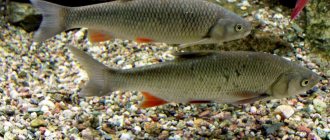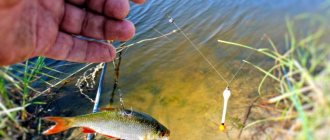In winter, most fish species are not very active, and some even hibernate until spring. This is especially evident in January-February, or, as fishermen say, in the dead of winter. A difficult time for both fish and anglers comes when the oxygen level in the water decreases significantly. In such conditions, underwater inhabitants almost completely stop, stop feeding, and do not pay any attention to bait. It would seem that what kind of fishing can we talk about, just sit at home and wait for the spring warmth. But there is still one fish that often helps out during periods of lack of biting, which is usual in the middle of winter.
In the summer, few people catch it purposefully, and when it is hooked, many people find it very annoying. But in winter it is a very worthy trophy. We are talking about roach (roach), which can approach the hole in a large flock and reward the fisherman for his patience with unforgettable fishing. It lives in all more or less large bodies of water (even stagnant ones), bites throughout the year (depending on the weather with varying success), and also grows to quite a decent size. A fish weighing half a kilo is a great trophy! That is why catching roach in winter is a very popular, exciting and gambling activity.
Place and time of fishing
A large number of sorog in water bodies does not mean that it is easy to catch. In the cold season, it does not move as actively as in summer; it is not always possible to lure it with a handful of bait. And if there is no fish under the hole, then neither finely tuned gear nor fishing tricks will help. In other words, you need to look for roaches, and this often takes a lot of time.

Roach fishing spots on the river in winter
According to many years of observations, in winter it sticks to certain places from which to start searching. Let's look at them in more detail:
- Deep holes. Great depths attract many peaceful fish with their comfortable conditions. Here you can hide from predators and “warm up” a little, because at a depth, starting from 7-8 meters, the water temperature is several degrees higher than at the surface. Typically, roaches do not change their winter mooring sites; these are the same pits from year to year. Finding them is quite simple; the guide is a dense cluster of fishermen or holes left by them.
- River bed. For wintering, roach also often chooses the riverbed part of a reservoir, where there is not only a suitable depth, but also a current. Lakes and reservoirs with standing water are not included here; this applies exclusively to rivers. Even a very weak water flow maintains the oxygen regime and brings food, and the fish don’t need anything else. It is not surprising that trophy specimens of sorog are most often found in such places.
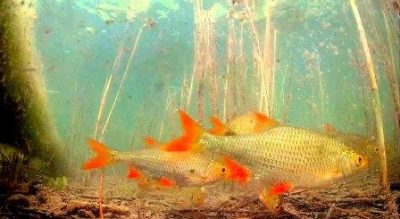
Bays. If the depth of the bay exceeds 3 meters, it should also be classified as a promising place. Although the fish here are smaller than in the river-bed pits, they are not so capricious. Just for a novice winter fisherman, especially since it’s easy to see the perimeter of the bay even in winter.- Areas with a relief bottom. Finding them on a familiar body of water is not a problem, but on an unknown one you can find them by accident. It happens that one fisherman has already “grown” a mountain of roach, but the neighbor next to him still hasn’t gotten a bite. What's the matter? The first one was lucky enough to land on a ridge, pit or some other bottom anomaly, and the second one lowers the bait onto a completely flat surface. In this case, he has only two options: wait until the competitor has caught enough and leaves, or look for his own catching place.
Roach is excellently caught at the beginning of winter, at the end and in early spring (on the first and last ice). During the day there are several bursts of activity of this fish. As a rule, this happens in the early morning, at midday and an hour and a half before dark.
Tackle and fishing methods
There are two main methods for fishing roach from ice: with and without bait. Any of these options can be effective, so the angler’s arsenal should include both a float rod and a rod for fishing with a no-attachment jig. The requirements for both are approximately the same:
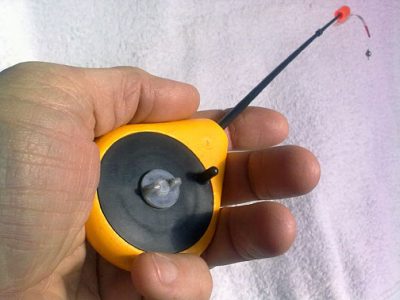
a light fishing rod with a reel (a balalaika is best);- long nod, allowing you to play the jig smoothly;
- high-quality monofilament with a thickness of 0.08-0.1 mm for a track weighing up to 200 g or 0.12-0.14 mm for larger specimens;
- a float with a carrying capacity of no more than 0.5 g, a pellet-shaped weight and a hook No. 3 or 4 according to the domestic classification (for a float fishing rod).
Float on the current
When fishing in the current, the tackle has a slightly different design. If you leave everything as is, the equipment will be dragged by the current. If you use heavier weights and, accordingly, a large float, then the tackle will be bulky and rough. Therefore, in this case, it is more logical to use a diverter leash. The tackle is also simple and consists of an “olive” or “pear” type sinker, a main fishing line and a leash with a hook. The float is used in summer. It can be adjusted to be on or below the surface of the water. The bite in this case will be determined as a jerk of the float to the side, going deeper.
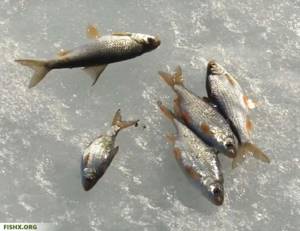
Fishing with a jig
No one is saying that roach is a stupid fish, but it is easy to catch it with artificial bait if you give the latter the right animation. Catching roach in winter with a jig involves using bait with a nozzle or a reelless one. The main technique in such fishing is smooth low-frequency vibrations of the bait, to which the sorog readily responds.
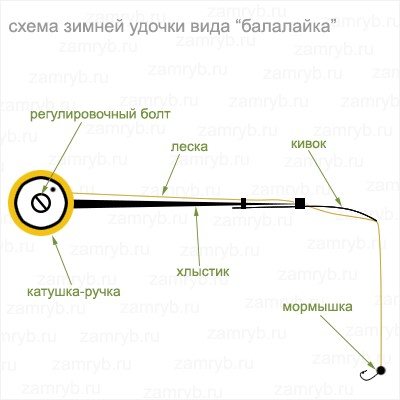
You can play with a jig over the bottom surface, while simultaneously raising it to a height of up to half a meter, slowly lowering it, or smoothly swinging it. Sometimes it is useful to pause to let the bait freeze in place, and then move it again. The roach can also be provoked to bite by lightly tapping the jig on the bottom soil, raising a small cloud of turbidity. The mood of the fished object sometimes changes at the speed of sound, so there is no way to do this without experimentation.
Let's consider the installation of equipment
The equipment consists of a long lead, which is also called a braid. It is necessary to attach hooks to it on separate leashes. The length of such a leash must be at least ten centimeters. And the distance between these leashes should be about half a meter (+/- 20 centimeters).
To prevent the equipment from being carried away by the current, it is necessary to install a sliding sinker at the end of our outlet leash. The shape of a simple olive is perfect. By weight, 5 grams will be enough.
In order for the angler to easily install and remove the gear, as well as transport it from place to place, the equipment is made removable.
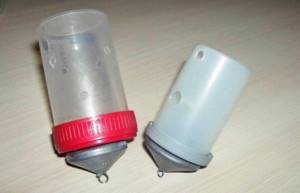
If you don’t have feeders, don’t despair, you can easily make them yourself. Plastic jars designed for collecting medical tests are perfect for serving as a feeder. Or cans from camera films (they used to be in every home). A weight must be attached to the jar. The weight of the load, as mentioned earlier, must be selected experimentally. So that it does not get carried away by the current.
You can also use store-bought feeder feeders, however, it is worth remembering that if the bait consists of bloodworms or jigs, then it must be a closed type.
The feeder is also attached to the main line with a lead leash approximately 20-25 cm long. A swivel is attached to the end of the leash, thanks to which the feeder slides along the main line, but its movements are limited by stoppers.

Fishing with a float
Catching roach in winter with a float does not involve any game; you just need to cast the tackle and carefully monitor the bite alarm. A float rod is a tool for sedate and important winter fishermen who do not want to look for a catching hole throughout the entire body of water. Many of them come in the evening to generously feed the chosen point, and in the morning to fully enjoy their favorite pastime. You can fish with such gear without a float, but provided that it is equipped with a sensitive guard.

To catch roach with a float rod, various baits and attachments are used. Bloodworms have always been and remain the best, followed by maggots, worms, dough and semolina. When biting actively, it is advisable to attach several larvae to the hook at once, so the bait will look even more tempting.
Where to look for roach in winter
During the cold season, roaches try to stay in those places where the oxygen concentration is highest. Therefore, you need to look for it in flowing streams and deep holes. As a rule, in such areas there is a rather soft muddy bottom, which makes it possible for fish to feed, since there are a sufficient number of different larvae in the mud.

If there is a forest near a rocky reservoir, then most likely you should look for roach in a place where there are a lot of fallen leaves, since stuck leaves favor the breeding of all kinds of living creatures that the fish feed on.
Of course, catch roach in winter using a jig, but only if there is no strong current in the reservoir, otherwise you will be left without a catch. Therefore, on fast-flowing rivers it is better to fish with a float rod.
To catch roach, it is advisable to cut more than 7 holes of small diameter. In this case, you should check each hole for the presence of roach; you need to fish each of them for at least 5 minutes to understand if there is fish in a given place.
Lure
Like any other fish, during the cold period the sorog prefers high-calorie protein foods, so animal components must be present in the bait. For example, bloodworms or crushed red worms. The basis is almost always breadcrumbs, and the fisherman selects the remaining ingredients at his own discretion. The following mixture has worked well:
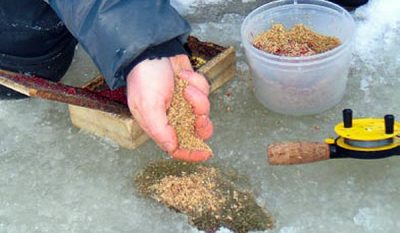
crackers – 60%;- ground sunflower seeds – 10%;
- bran – 10%;
- milk powder for binding – 10%;
- bloodworm – 10% (added immediately before use).
It is worth noting that roaches have a highly developed sense of smell, so odorous substances will not interfere with the bait. In the recipe described, these are seeds that must be fried before grinding. Instead, they also often use ready-made cake (in common parlance, makukha).
Fishing tactics
If the reservoir has been studied for a long time and the fish’s resting places are known, then successful fishing can only be hindered by bad weather. On an unfamiliar lake or river, you will have to conduct “reconnaissance in force.” First you need to choose a promising site, focusing on the coastal topography and old holes. Then feed them or drill a dozen of your own at intervals of at least 7-8 meters.
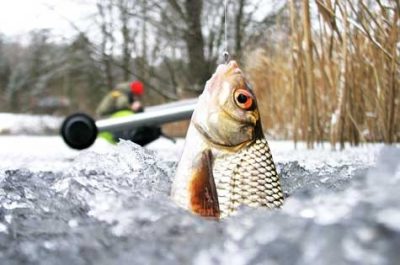
When all the holes have been fed (with a small amount of food), you can start searching for roach, catching them one by one. You should start with the one in which the first portion of the bait mixture went and gradually move towards the last.
If confident bites occur on one of the holes, this is not a reason to stay on it until the end of fishing, forgetting about the others. She needs to be fed thoroughly, that is, add more food, and move on. Thus, after fishing the entire area, only two or three working holes will remain, under which the roach will stand, attracted by tasty food.
How to make a float with your own hands
The classic float for winter fishing has a very simple design. You can do it yourself without much difficulty. For this you will need:
- a piece of polystyrene foam,
- a little bright paint
- 5 cm of wire with a diameter of 0.30 mm.
It is necessary to cut a small cylindrical piece from a piece of dense foam. After that, the workpiece must be given a cone-shaped shape and treated with sandpaper.
We divide the piece of wire into two equal parts. We bend one of the resulting short segments in the middle. We take it with our fingers at the bend, and begin to twist the remaining ends with pliers until we get a small spiral with an eye. We insert the remaining piece of wire into the eye of the previously formed spiral and repeat the twisting procedure.
The result is a hinged connection of two spirals, one of which must be moistened with quick-drying glue and screwed into the upper part of the foam cone. After this, all that remains is to paint the float in a bright color and wait for the paint to dry. The float is attached to the fishing line using a silicone cambric.
